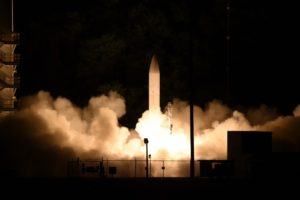The Pentagon has completed a successful flight test of its hypersonic weapon glide body, a key milestone as the department looks to field a hypersonic weapon in the early-to-mid 2020s.
The Army and Navy jointly conducted the launch of Common Hypersonic Glide Body (C-HGB) from the Pacific Missile Range Facility in Kauai, Hawaii at 10:30 p.m. local time, which included flying the glide body at hypersonic speed to reach a designated impact point.

”This test builds on the success we had with Flight Experiment 1 in October 2017, in which our C-HGB achieved sustained hypersonic glide at our target distances,” Vice Adm. Johnny Wolfe, the Navy’s director of strategic systems programs, said in a statement. ”In this test we put additional stresses on the system and it was able to handle them all, due to the phenomenal expertise of our top notch team of individuals from across government, industry and academia. Today we validated our design and are now ready to move to the next phase towards fielding a hypersonic strike capability.”
C-HGB is being designed by the Navy and will ultimately be produced by the Army, and is set to encompass the future hypersonic strike capabilitiy’s conventional warhead, guidance system and thermal protection shield.
”This test was a critical step in rapidly delivering operational hypersonic capabilities to our warfighters in support of the National Defense Strategy,” Lt. Gen. Neil Thurgood, the Army’s lead officials for hypersonics efforts, said in a statement. “We successfully executed a mission consistent with how we can apply this capability in the future. The joint team did a tremendous job in executing this test, and we will continue to move aggressively to get prototypes to the field.”
The C-HGB will be utilized across each of the services’ hypersonic weapon efforts, with ongoing programs to develop individual weapon systems and launchers for their respective domains.
“The glide body tested today is now ready for transition to Army and Navy weapon system development efforts and is one of several applications of hypersonic technology underway across the department. These capabilities help ensure that our warfighters will maintain the battlefield dominance necessary to deter, and if necessary, defeat any future adversary,” Mike White, the Pentagon’s assistant director for hypersonics, said in a statement.